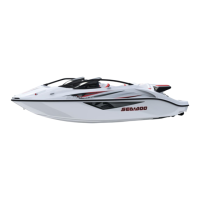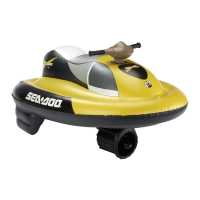Section 11 HULL/BODY
Sub-Section 02 (ADJUSTMENT AND REPAIR)
11-02-25
INSTALLATION ON PLASTIC (STORAGE
COVER)
Clean surface with isopropyl alcohol.
Using a pencil and the decal as a template, mark
the area where decal will be located.
Apply an activator (P/N 293 530 036) to prepare
the surface using a clean cloth. After a few sec-
onds, when the activator evaporates, the surface
is ready.
Remove back protective film from decal and care-
fully align decal with marks. When well aligned
squeegee decal beginning at center and working
outward using firm, short, overlapping strokes.
Remove front protective film once decal has ad-
hered.
HULL AND BODY REPAIR
General
Gelcoat is the smooth and durable cosmetic finish
which coats the fiberglass hull and body of a Sea-
Doo watercraft. It also provides a protective barri-
er against water and sun. It consists of a mixture
of resin, pigment (coloring), fillers, monomers and
catalyst which is sprayed into the mold.
The body and hull of the Sea-Doo are constructed
of chopped fiberglass, saturated with resin. It is
sprayed on the layer of gelcoat along with pieces
of fiberglass mat, cloth and woven rowing which
are added at required areas. This type of construc-
tion is very accommodating for high quality re-
pairs. With patience, the proper techniques and
materials, a damaged area can be restored to an
original finish.
NOTE:
Fiberglass repair kit is available through
automotive or marine suppliers. Gelcoat repair
kits are available through regular channel.
Air Bubbles
Possible Cause:
– Air pocket trapped between layers of laminate
and gelcoat.
PREPARATION OF SURFACE
Remove all of the damaged gelcoat surrounding
the air bubble with a putty knife or preferably a
carbide grinding tip. Make sure all loose and weak
areas are completely removed. Sand a small area
of the gelcoat surface with 220-grit sandpaper. If
needed, sand the cavity itself. These areas must
have a rough surface to allow the gelcoat putty to
bond properly.
FILLING THE CAVITY
The prepared surface must be cleaned with ace-
tone on a cloth. Use the Bombardier gelcoat repair
kit (P/N 295 500 100). Follow the mixing instruc-
tions in the kit when preparing the gelcoat putty.
Carefully mix the required amount while making
sure there are no air bubbles in the mixture. With
a putty knife, fill the repair area and cover with
plastic film. Curing time may depend on tempera-
ture, amount of putty and percentage of catalyst.
After 2 hours, press lightly on the surface with fin-
gers to test the hardness. When the area be-
comes hard, remove the plastic film.
-
CAUTION
Do not use soapy water to locate decal on
plastic parts.
;
WARNING
Protect skin, wear gloves when in contact
with resin, hardeners and gelcoat. A barrier
skin cream may also be used. Do not expose
area to open flame or lit cigarette. Some of
the materials are flammable. Protect eyes,
wear safety glasses when grinding, sanding
or spraying. Use a dust mask when sanding
or grinding. When spraying wear a respira-
tor or paint mask. Always read warning la-
bels on products.
